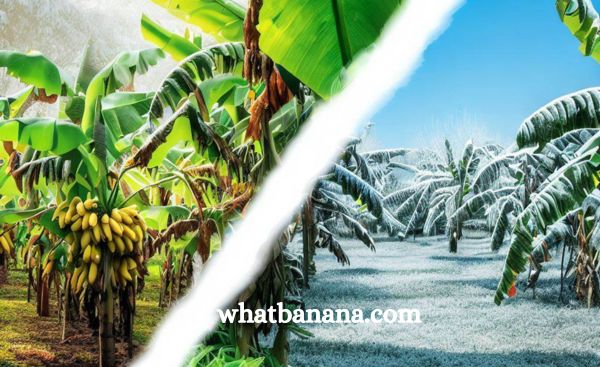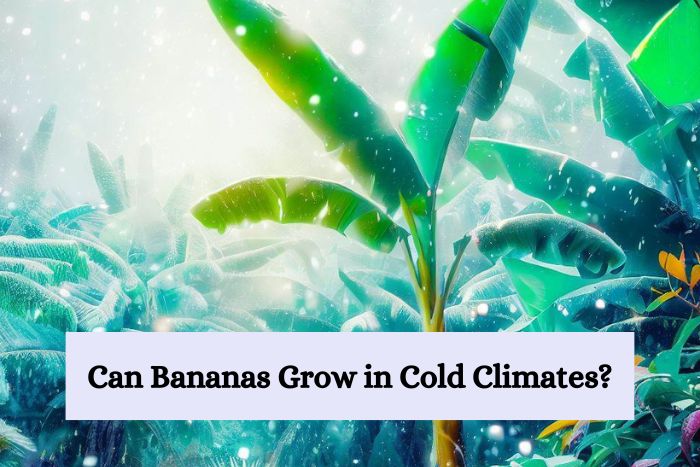Hey there, fellow gardening enthusiasts!
Are you tired of longing for luscious banana trees, only to be told they won’t thrive in your cold climate?
Well, fear not!
❄️ In this article, I’m here to answer the burning question on every green thumb’s mind: Can bananas actually grow in cold climates?
Brace yourselves for an exciting journey as we explore the possibilities and unveil expert tips and tricks to make your frosty garden dreams come true!
❄️ So grab your gardening gloves and let’s dive right in, because you might just be one step away from enjoying your very own homegrown bananas, no matter where you live! ✨
🍌 Top 5 Most Popular Banana Varieties 🍌 |
||
|---|---|---|
| 🍌 Banana Variety | 📝 Description | 🌍 Popular in Region |
| Cavendish | The most common variety, often found in grocery stores. | Worldwide |
| Lady Finger | Smaller and sweeter than Cavendish bananas. | Worldwide |
| Red Banana | Have a slight raspberry flavor and are often used in desserts. | Worldwide |
| Plantain | Usually cooked and popular in Latin American and Caribbean cuisine. | Latin America, Caribbean |
| Manzano (Apple Banana) | Have a taste reminiscent of apples and strawberries. | Worldwide |
| Brought to You by whatbanana.com | ||
Bananas in the Snow: Yes, It’s Possible! Find Out How!
Bananas can grow in cold climates, provided that cold-hardy varieties are chosen and appropriate protective measures are taken. Cold-tolerant banana varieties like Musa basjoo and Raja Puri can withstand freezing temperatures, while techniques such as mulching, covering, and using frost protection devices can help safeguard banana plants from frost damage. With careful planning and proper care, gardeners can enjoy homegrown bananas in even the chilliest of climates.
Can Bananas Survive Freezing Temperatures?
I suppose we typically associate bananas with warm, tropical climates.
So, is it possible they can withstand colder temperatures?
Surprisingly, there are some specific cold-hardy varieties of banana plants.
I’ve actually had some success growing the Musa basjoo banana, which is also known as the Japanese fiber banana.
It is quite resilient and can actually cope with temperatures as low as -10°C (14°F) during the winter.
And still produce lush, green leaves when spring comes around!
If you experience even colder weather, there are actually some methods of protecting your banana plant from frost damage.
I will offer some handy tips later in this article.
So, don’t let freezing temperatures hold you back from enjoying homegrown bananas! ❄️

What Cold-Hardy Banana Varieties Exist?
Having established that bananas are not just a tropical fruit, let’s look at the plants that can thrive in colder climates.
With care and attention, you can encourage these to grow even when the temperatures fall.
Let’s start in the high altitudes of India, where we find the Raja Puri banana.
This amazingly resilient plant can still produce bananas even after the temperatures have dropped to -6°C (21°F).
You can also consider the Dwarf Cavendish banana, which is a compact variety and a favorite with gardeners in cooler climates.
And finally, the Veinte Cohol banana, originating in the Philippines, which can even survive a frost!
It’s amazing to see how these bananas can defy the odds and bring tropical vibes to even the chilliest of gardens!

How Can I Protect My Banana Plants from Frost Damage?
If you live in a colder climate, then it is inevitable at some point that you will see frost during the winter.
So, let’s see what you can do to protect your banana plant.
- Mulching: Apply a thick layer of organic mulch around the base of the plants to insulate the roots and retain heat.
- Covering: Use blankets, frost cloths, or burlap to create a protective barrier around your banana plants during cold snaps.
- Heating: Install frost protection devices like heat lamps or even Christmas lights near your plants to generate warmth and prevent freezing.
- Windbreaks: Erect windbreaks or plant tall, dense shrubs or trees around your banana plants to shield them from harsh winds.
The number one rule is prevention!
Always study the weather forecast and take action in advance to protect your banana tree.
With the right protection, your bananas can thrive, even in colder temperatures.
Protecting Banana Trees During Winter
Key Takeaways
- Bananas can thrive in cold climates if you select cold-hardy varieties like Musa basjoo and Raja Puri.
- Protective measures such as mulching, covering with blankets or frost cloths, and using heat lamps or Christmas lights can help shield banana plants from frost damage.
- Choosing a sheltered location, providing ample sunlight, optimizing soil conditions, and pruning strategically are essential for successful banana cultivation in cold climates.
- By taking these precautions, gardeners can enjoy the beauty and taste of homegrown bananas, just like enthusiasts who have successfully grown Musa basjoo in regions with freezing temperatures.
- With the right techniques and a little extra care, your cold climate garden can become a tropical paradise with flourishing banana plants.
In conclusion, don’t let a cold climate deter you from growing your own bananas.
With the right knowledge and techniques, you can transform your frosty garden into a tropical haven.
So, are you ready to embark on the journey of growing bananas in your cold-climate garden?
